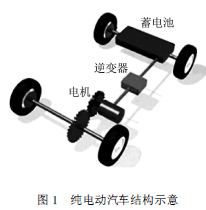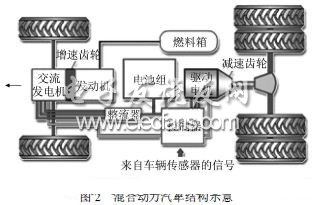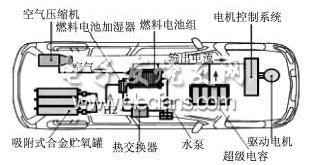With the development of China's society and economy, household cars will continue to be popularized, and the energy consumption and emissions of automobiles will continue to increase. Therefore, it is imperative to develop and promote clean and efficient car power. Electric vehicles can be independent of petroleum resources, energy efficiency is 1.5 to 2.0 times that of traditional fuel vehicles, and can reduce carbon dioxide by 20% over the life cycle compared with fuel vehicles. Therefore, it is considered to be the most promising vehicle. China has included the development of electric vehicles in the "Twelfth Five-Year Plan" and is preparing to develop electric vehicles on a large scale in the next few years.
This article refers to the address: http://
1 electric car type
Generally, electric vehicles include Pure Electric Vehicle (PEV), Hybrid Electric Vehicle (HEV), and Fuel Cell Electric Vehicle (FCEV). In recent years, external charging in hybrid vehicles (Plug- In) Hybrid Vehicle (Parallel Hybrid Electric Vehicle, PHEV) is particularly concerned, and domestic and foreign experts believe that PHEV is expected to be widely used after several years.
1.1 pure electric car
A pure electric vehicle is an electric vehicle that is powered by a power battery. See Figure 1. Currently, lead-acid batteries, nickel-hydrogen batteries, and lithium-ion batteries are used as driving forces.

Lead-acid batteries are very mature batteries, and the price is relatively cheap. Although the manufacture and disposal of lead-acid batteries have serious shortcomings that focus on metal pollution, they are also important driving power for electric vehicles in the near future.
Ni-MH batteries have high specific energy and long service life, but nickel-metal hydride batteries need to use high-priced nickel metal (60% of the cost), so the manufacturing cost is high, and it is very difficult to promote a large number of them.
Lithium-ion battery technology has developed rapidly. In the past 10 years, the specific energy has increased from 100Wh/kg to 180Wh/kg, the specific power can reach 2kW/kg, the cycle life is more than 1000 times, and the working temperature range is -40~55°C. In recent years, due to the major breakthrough in the research and development of lithium iron phosphate battery, and greatly improved the safety of the battery, many developed countries have adopted lithium-ion batteries as the main direction of power batteries for electric vehicles. China has the advantage of lithium resources. In 2004, the output of lithium batteries accounted for 37.1% of the global market. It is expected that after 2015, the price/performance ratio of lithium-ion batteries is expected to reach the level of competition with lead-acid batteries, and become the main power battery for electric vehicles in the future. .
Based on the energy conversion efficiency, a rough comparison can be made between the economics of pure electric vehicles and fuel vehicles. Assume that the battery's highest chargeable state (StateOfCharge, SOC) is 0.9, the discharge SOC is 0.2, that is, the actual available battery capacity only accounts for 70% of the total capacity; the grid power supply price is 0.5 yuan / kWh, the average charge and discharge of the battery The efficiency is 0.75. Roughly calculated, the lead-acid battery provides 1kWh of electric energy, and the price is about 3.05 yuan (including 2.38 yuan for battery depreciation, 0.67 yuan for grid power supply), nickel-hydrogen battery for 1kWh of electricity, the cost is 9.6 yuan, lithium-ion battery is 10.2 yuan.
1.2 Hybrid Electric Vehicle
Hybrid electric vehicles have more than two power sources, one of which can release electrical energy, as shown in Figure 2.

Hybrid vehicles can be divided into three types: series, parallel and hybrid. According to the degree of mixing (the ratio of motor power to internal combustion engine power), they can be divided into micro-mixing, light mixing and full. Mix three. Among them, the external belt drive start/generation (BSG) type is a typical structure of a micro hybrid vehicle. The motor power used is generally only 2~3kW, and it has the engine shut-off function, which can save fuel by 5%~7%. A typical structure of a mild hybrid vehicle is equipped with an electric/generator type disc motor (ISG) at the rear end of the crankshaft of the automobile engine. The fully hybrid or hybrid hybrid car uses pure electric drive capability, and Toyota's Prius sedan is part of this all-hybrid car. At present, most of the hybrid vehicles developed in China adopt ISG mild mixing or BSG micro-mixing schemes, mainly considering the technical difficulty of these two schemes and the production cost is also low. However, according to research, the fuel economy of hybrid vehicles is almost proportional to the hybridity of vehicle power, so it is an inevitable trend to promote and develop fully hybrid electric vehicles in the long run. Toyota Motor Corporation took the lead in launching the Pioneer Hybrid (Prius) hybrid car in 1997, and has achieved great success in Japan, the United States and European markets, with cumulative production and sales exceeding 600,000 units. Subsequently, Honda of Japan, Ford of the United States, GM and some large European companies also introduced various types of hybrid vehicles to the market.
As the latest generation of hybrid electric vehicles, the external plug-in hybrid electric vehicle (PHEV) has received widespread attention from governments, auto companies and research institutions in recent years. PHEV uses large-capacity power batteries in hybrid vehicles. The battery capacity is generally 5~10kWh, which is about 30%~50% of the battery capacity of pure electric vehicles. It is 3~5 times of the battery capacity of general hybrid vehicles, so it can It is a transitional product between a hybrid car and a pure electric car. Compared with traditional internal combustion engine vehicles and general hybrid vehicles (HEVs), PHEVs rely more on power battery-driven vehicles, which usually ensure that vehicles use pure electric drive for 50~90km. Only when the vehicle exceeds this mileage, the internal combustion engine needs to be started. . As a result, its fuel economy is further enhanced, with less carbon dioxide and nitrogen oxide emissions.
According to statistics: 80% of the daily average driving distance of French urban residents is less than 50km; in the United States, more than 60% of the average car driving distance is less than 50km, and more than 80% of the daily average mileage is less. At 90km. Therefore, PHEV has good applicability, and is especially suitable for working people who commute to work 5 days a week and between 50 and 90 km. 1.3 fuel cell electric car
Fuel cell electric vehicles use proton exchange membrane fuel cells (PEMFC) as the engine drive power source. The typical structure is shown in Figure 3. As a hydrogen fuel cell, PEMFC emits water and water vapor, so it can be said to have zero pollution to the environment. PEMFC energy conversion efficiency is as high as 60%~70%, and it operates without mechanical vibration, low noise and low heat radiation. As a hydrogen fuel cell fuel, hydrogen has a high calorific value, and the calorific value of 1 kg of hydrogen and 3.8 L of gasoline is equivalent. In China, the Ministry of Science and Technology has listed fuel cell buses and fuel cell cars as “10th Five-Year Planâ€, “Eleventh Five-Year Plan†and “863†major science and technology projects, and has achieved a series of major scientific and technological achievements.

However, there are still many problems to be solved in the current PEMFC.
First of all, the durability life of fuel cells is short. At present, the service life of PEMFCs developed in China is generally only 1000~1200h (2200h abroad); the driving power of fuel cell vehicles will drop by about 40% after driving 4~50,000km, in contrast, Traditional internal combustion engine vehicles can generally travel 500,000 km, a big gap.
Secondly, the cost of manufacturing and operating fuel cell engines is high. Especially the current PEMFC technology in China is relatively backward. The key materials and key components such as proton exchange membrane, carbon paper, platinum metal catalyst, high purity graphite powder and hydrogen recovery are needed. Pumps, charge air pumps, etc. can only rely on imports, and the price is very high. At present, China's fuel cell engine manufacturing cost is about 30,000 yuan / kW (foreign cost is 3,000 US dollars / kW), compared with the traditional internal combustion engine only 200 ~ 350 yuan / kW manufacturing cost is huge. The cost of using fuel cell vehicles is also too high. For example, high-purity (99.999%) high-pressure (more than 20 MPa,) hydrogen is used. The current price is about 80-100 yuan/kg. According to 1kg hydrogen, 10kWh energy can be calculated. The fuel cost is about 10 yuan / kWh. The total operating power cost of the fuel cell engine includes the depreciation charge. The depreciation charge of the fuel cell working life is 1000 yuan/kWh calculated at 1000 hours, so that the total power cost of the fuel cell vehicle will reach 40 yuan/kWh.
Again, PEMFC is very adaptable to the work environment. Domestic PEMFC can work at 0~40°C temperature, there is ice problem below 0°C, and overheating above 40°C can't work normally. The PEMFC in operation is very sensitive to dust, carbon monoxide and sulfide in the air, and the platinum catalyst is highly susceptible to poisoning and poisoning failure. In addition, hydrogen as a gas, its storage and distribution also has many difficulties to be solved.
Despite the many problems, fuel cell vehicles are still one of the cleanest and most promising new energy vehicles. As long as there are further breakthroughs in technology, the cost will drop significantly, and fuel cell vehicles are entirely possible to promote. .
2 electric vehicle charging and discharging technology
With the improvement of the intelligent level of distribution network and the advancement of demand side management technology, the vehicle battery of electric vehicles may be used as a mobile energy storage unit in the smart grid. Vehicle electrical interconnection (V2G) refers to the electric vehicle as a mobile energy storage unit connected to the power grid, and realizes two-way interaction between information and energy in the controlled state. The construction of electric vehicle charging and discharging station is important for the smart grid power supply link. content. The average vehicle travels only 1 hour per day, 95% of the time is in a stopped state; when the number of electric vehicles connected to the grid is sufficient, it can be effectively used as a mobile distributed energy storage device for peak-cutting and balancing loads. Especially in the microgrid system with a high proportion of renewable energy generation that may be formed in the future, the reasonable charge and discharge of electric vehicles can effectively balance the volatility of renewable energy and help the grid to effectively accept renewable energy.
At present, electric vehicle charging and discharging technology mainly has a one-way disordered VOG mode, a one-way ordered TC and V1G mode, and a two-way ordered V2G mode.
2.1 One-way disordered power supply
VOG (VehiclesPlug-inwithoutLogic/Control) refers to the electric vehicle as a common electric equipment, using mature one-way converter technology, which can be connected to the grid for immediate charging mode. VOG is currently the most common charging method for electric vehicles, such as golf carts, airport shuttle buses and other special electric vehicles, as well as some new public charging facilities at home and abroad, and such charging methods as the Beijing Olympic electric vehicle charging station. At present, the biggest problem with VOG is that electric vehicle charging is used as a high-power, unconstrained use of electric load, which means that the operation of VOG charging increases the difficulty of peak shaving.
2.2 One-way ordered power supply
The TC (TimedCharging) mode, that is, the time control mode, is a charging mode of single-phase ordered power supply. In this mode, the electric vehicle is charged in a given period of time, and the charging time is controlled to realize the peak charging, thereby avoiding charging during the peak load period of the power grid, and at the same time, the user can also enjoy the discount of the valley power. However, for various reasons, the current time control mode cannot flexibly control the charging process based on the grid peak and valley states. This mode of charging still uses one-way converter technology, does not need to communicate with the grid in real time, the current technical equipment has matured, has entered the demonstration operation stage.
V1G (VehiclesPlug-inwithLogic/ControlRegulatedCharge) is also a charging mode for single-phase ordered power supply. With this mode, the electric vehicle communicates with the grid in real time, and the charging is controlled by the grid, which can be charged at the time allowed by the grid, and the grid efficiency is improved by optimizing the charging arrangement. At present, the Pacific Northwest National Laboratory (PNNL) has released a charging control device for electric vehicles called "SmartChargerController", equipped with a short-range wireless communication module, which can receive information such as electricity price setting from power companies, and with the smart grid. The combination of technology automatically avoids charging during peak hours. The device's ZigBee/IEEE802.15 standard has been submitted to the IEC, and the application is an international standard. It has now become the standard for the US Smart Grid 1.0 wholesale distribution.
2.3 Conversion of bidirectional ordered energy
Electric vehicles use one-way technology to charge only the power from the grid. The excess energy cannot be fed back into the grid. The charging mode of the two-way ordered electric energy conversion can be used as a mobile energy storage unit for bidirectional electric energy conversion with the electric grid. Household cars are in a state of cessation for most of the time. If the number of electric vehicles connected to the grid is sufficient, it can be used as a mobile distributed energy storage device to cut peaks and fill valleys, balance loads, etc., and improve the efficiency of grid operation. Electric vehicle users bring direct economic benefits.
Using V2G (VehicleToGrid) mode, the electric vehicle communicates with and is controlled by the energy management system of the power grid to realize energy conversion (charge and discharge) of the electric vehicle and the power grid. At present, V2G related research and demonstration are mainly carried out in the United States. In October 2007, the United States University of Terry China successfully connected an ACPropulsioneBox (ToyotaScion modified vehicle) to the power grid and received dispatching instructions. The vehicle was operated as a frequency modulation and backup power generation equipment. According to the demonstration operation, each car can bring about 4,000 US dollars in benefits per year to the power companies.
The Shanghai Electric Power Company has now built two electric vehicle charging and discharging demonstration stations with V2G functions in the Tunxi electric vehicle charging and discharging station and the National Electric Grid Museum charging and discharging station. Each station has a 30kW DC V2G charging and discharging machine, which can be used as a conventional charger to realize instant charging, scheduled charging, etc., and can also dynamically adjust the working state and power according to the background management system to accept the power grid dispatching instructions to realize electric vehicles. Two-way energy interaction with the grid. At present, the V2G model is still in the experimental demonstration stage, and there is no market environment for commercial operation. To this end, advanced grid communication, dispatching, control and protection technologies are needed. The peak-to-valley electricity price policy and the support of electric vehicles to the grid to provide peaking and FM adjustment and demand response are supported.
Gasoline Generator,Fule Tank Generator Set,Silent Trailer Diesel Generator,Small Diesel Power Generator
XCMG E-Commerce Inc. , https://www.xcmg-generator.com